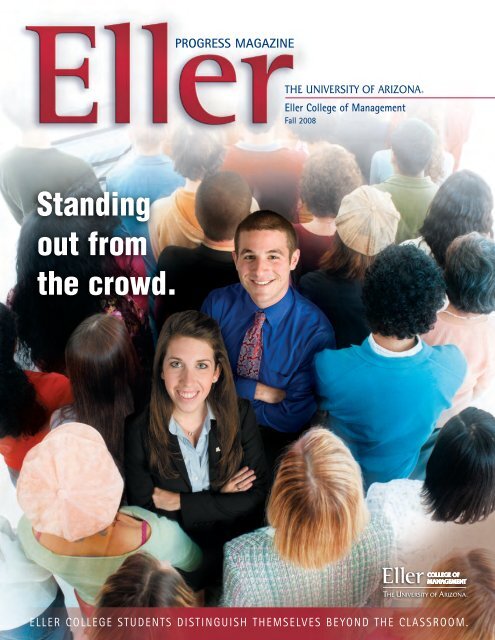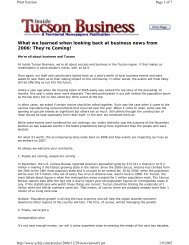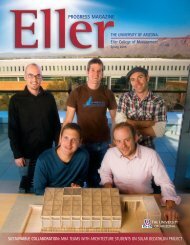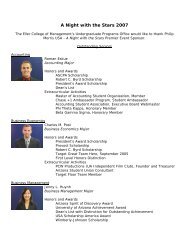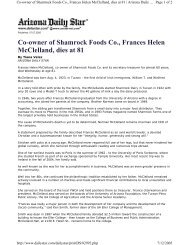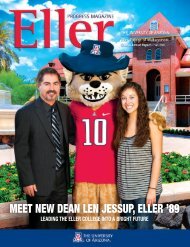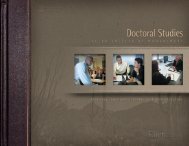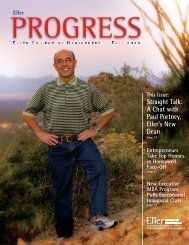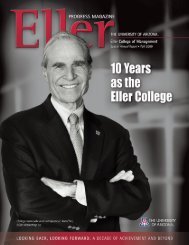Standing out from the crowd. - Eller College of Management ...
Standing out from the crowd. - Eller College of Management ...
Standing out from the crowd. - Eller College of Management ...
You also want an ePaper? Increase the reach of your titles
YUMPU automatically turns print PDFs into web optimized ePapers that Google loves.
PROGRESS MAGAZINETHE UNIVERSITY OF ARIZONA ®<strong>Eller</strong> <strong>College</strong> <strong>of</strong> <strong>Management</strong>Fall 2008<strong>Standing</strong><strong>out</strong> <strong>from</strong><strong>the</strong> <strong>crowd</strong>.ELLER COLLEGE STUDENTS DISTINGUISH THEMSELVES BEYOND THE CLASSROOM.
Fall 2008P R O G R E S S M A G A Z I N EFrom <strong>the</strong> DeanLast year, <strong>the</strong> <strong>Eller</strong> <strong>College</strong> <strong>of</strong><strong>Management</strong> passed with flyingcolors its regular five-yearaccreditation review conductedby <strong>the</strong> Association for <strong>the</strong>Advancement <strong>of</strong> CollegiateSchools <strong>of</strong> Business. It’s nice to Paul Portneyreceive confirmation that <strong>the</strong>research <strong>of</strong> our faculty and programs <strong>of</strong> study we’vecreated at <strong>the</strong> undergraduate, master’s, and Ph.D. levelsare meeting <strong>the</strong> needs <strong>of</strong> students and industry.We pride ourselves in delivering a rigorous education,and I like to think that we keep <strong>Eller</strong> students extremelybusy with <strong>the</strong> academic demands we place on <strong>the</strong>m. Butmany <strong>of</strong> our students also take on Herculean projectsand responsibilities above and beyond <strong>the</strong> requirements<strong>of</strong> <strong>the</strong>ir degree programs. On page 12, you’ll find storiesab<strong>out</strong> a few <strong>of</strong> <strong>the</strong>se <strong>out</strong>standing students, who haveshoehorned activities as diverse as intercollegiateathletics and student leadership into <strong>the</strong>ir alreadypacked schedules.I also look forward to hearing your views as we prepareto develop a new strategic vision to guide <strong>the</strong> <strong>Eller</strong><strong>College</strong> into <strong>the</strong> future. Among <strong>the</strong> topics we will consider:how to take greater advantage <strong>of</strong> our pre-eminentreputation in entrepreneurship and managementinformation systems; how to pull toge<strong>the</strong>r our faculty’sstrengths and interests in leadership, governance,and corporate social responsibility to create a brandadvantage among schools <strong>of</strong> business and publicadministration; and, perhaps most ambitiously, whe<strong>the</strong>rand how to expand our physical space to better serveour 5,200 undergraduate and 700 graduate students.I look forward to sharing information ab<strong>out</strong> <strong>the</strong>sedevelopments with you in future issues <strong>of</strong> <strong>Eller</strong>Progress magazine.FEATURE12 <strong>Standing</strong> Out<strong>Eller</strong> Students Go Above and BeyondBRIEFINGS2 McClelland Pr<strong>of</strong>essor <strong>of</strong> Accounting Leslie Eldenburg Appointed Vice Dean3 Paulo Goes Joins <strong>Eller</strong> <strong>College</strong> as MIS Department Head4 New Faculty at <strong>the</strong> <strong>Eller</strong> <strong>College</strong>RESEARCH REPORT6 Networks Expert Keith Provan Collaborates with ArizonaCancer Center on New Grant7 Alumnus Stephen Robbins Funds Research and Study Space for<strong>Management</strong> Ph.D. StudentsINNOVATIONS8 <strong>Eller</strong> <strong>College</strong> Spearheads Creation <strong>of</strong> Sports <strong>Management</strong> Minor9 Entrepreneurship Students Come Out on Top Among MobilePhone Industry InnovatorsCONNECTIONS10 McGuire Center for Entrepreneurship Heads Rural EntrepreneurshipComponent <strong>of</strong> State-Wide Grant11 Marketing Class Project Turns into Lucrative ContractGATHERINGS22 Save <strong>the</strong> Date23 Distinguished Speaker SeriesALUMNI NOTES & PROFILES24 Pr<strong>of</strong>ile: David Gemelli, MBA ’7225 Pr<strong>of</strong>ile: Sarah Brown Smallhouse, MBA ’8725 Pr<strong>of</strong>ile: Marc Blackman, BSBA ’8227 Alumni NotesLAST WORD28 Last Word on…LeadershipLouise Francesconi, <strong>Eller</strong> National Board <strong>of</strong> AdvisorsOn <strong>the</strong> Cover: <strong>Eller</strong> students and Associated Students <strong>of</strong> TheUniversity <strong>of</strong> Arizona leaders Jessica Anderson and Tommy Bruce.Let Us Hear <strong>from</strong> You Please e-mail comments,questions, or feedback to progress@eller.arizona.edu.Paul R. PortneyDean and Halle Chair in LeadershipManager <strong>of</strong> Marketing and Communications and Editor: Liz Warren-Pederson• Publications Manager: Marsha Dean • Photography: Thomas Veneklasen (unless o<strong>the</strong>rwise noted)• Design and Production: Shevon Johnson Design, Inc. • © 2008 The University <strong>of</strong> ArizonaCorrection: The story on page 2 <strong>of</strong> <strong>the</strong> Spring/Summer issue <strong>of</strong> Progress magazine incorrectly spelled <strong>the</strong> name <strong>of</strong> financier Warren Buffett.FALL 20081
BRIEFINGSExceptional ContributionMcClelland Pr<strong>of</strong>essor <strong>of</strong> Accounting Leslie Eldenburg Appointed Vice Dean.NEW FACULTY AT THE ELLER COLLEGE<strong>Eller</strong> <strong>College</strong> welcomes four new faculty memebers to itsexceptional team <strong>of</strong> researchers and educators.This year, McClelland Pr<strong>of</strong>essor <strong>of</strong>Accounting Leslie Eldenburg was appointedvice dean <strong>of</strong> <strong>the</strong> <strong>Eller</strong> <strong>College</strong>, stepping upafter SRP Pr<strong>of</strong>essor Stan Reynolds completedfour years in <strong>the</strong> <strong>of</strong>fice.“I always think ab<strong>out</strong> where I can make<strong>the</strong> most contribution,” says Eldenburg.“When I was initially approached ab<strong>out</strong> <strong>the</strong>position, I hesitated, because I felt I wasmaking a difference at <strong>the</strong> department level,working with Ph.D.s and mentoring juniorfaculty. But because <strong>of</strong> my cost accountingbackground, I knew I had a skillset that Icould bring to <strong>the</strong> vice dean position. Over<strong>the</strong> next three years, I think I can make aneven larger contribution than I was makingas a faculty member.”Eldenburg earned her undergraduatedegree in special education and taught for anumber <strong>of</strong> years after serving in <strong>the</strong> PeaceCorps in what is now <strong>the</strong> DemocraticRepublic <strong>of</strong> <strong>the</strong> Congo. She stayed at homewith her young son, and eventually returnedto <strong>the</strong> workforce at Virginia Mason Hospitalin Seattle. She moved into an accountingposition at <strong>the</strong> hospital after earning herMBA, but found that she missed teaching.So she went back for her Ph.D., and has beenwith <strong>the</strong> <strong>Eller</strong> <strong>College</strong> since 1993.In her new role as vice dean, Eldenburgcites priorities including satisfying recruiterdemand for diverse hires and recognizing <strong>the</strong>value added by hard-working <strong>Eller</strong> faculty.“People contribute hugely here at <strong>Eller</strong>, wherewe work under significant resource constraints,”she says.Biomedical Communications photoLeslie EldenburgEldenburg notes that <strong>the</strong>re are interestingparallels between <strong>the</strong> way that hospitalsand universities are structured today.“I’d describe <strong>the</strong>m as quasi-governmentnon-pr<strong>of</strong>it organizations,” she says. “Publicuniversities today are not fully funded by<strong>the</strong> state, and are heavily reliant on donorsand tuition.” In some respects, this hybridmodel presents challenges; <strong>the</strong> public universitymust satisfy government and regulatorystakeholders, as well as <strong>the</strong> donorswho give so <strong>the</strong> <strong>College</strong> can shine. But,says Eldenburg, this structure is not new to<strong>Eller</strong>. “At <strong>Eller</strong>,” she says, “We’ve alwaysbeen a hybrid because we are true entrepreneursand have been able to be morenimble in our operations.”Building New PartnershipsPaulo Goes joins <strong>Eller</strong> as department head <strong>of</strong> top-five MIS program.After a nationwide search, Paulo Goeshas been appointed department head <strong>of</strong><strong>the</strong> <strong>Eller</strong> <strong>College</strong>’s top-five MIS program.“The research and quality <strong>of</strong> <strong>the</strong> programcaught my attention,” he says. “Thedepartment already has a great reputation— <strong>the</strong> best technical researchers in<strong>the</strong> country are here — and I am excitedab<strong>out</strong> <strong>the</strong> potential to leverage thatexpertise to build new partnerships.”Goes comes to The University <strong>of</strong>Arizona <strong>from</strong> <strong>the</strong> University <strong>of</strong>Connecticut, where he built a collaborativebusiness relationship with GE, <strong>the</strong>centerpiece <strong>of</strong> which is edgelab, abusiness laboratory where University<strong>of</strong> Connecticut faculty and studentswork side-by-side with GE managerson strategic projects. “The partnershipchanged <strong>the</strong> way I think ab<strong>out</strong> academia,”he says. “Information systems ismultidisciplinary; we are <strong>the</strong> glue thatholds everything toge<strong>the</strong>r. There isenormous potential for working withcompanies in this capacity, as well aswith o<strong>the</strong>r departments in <strong>the</strong> <strong>College</strong>.”Goes believes <strong>the</strong>re is potential todevelop similar, mutually beneficialcollaborations between The University <strong>of</strong>Arizona and corporations through<strong>out</strong> <strong>the</strong>region. “The existing reputation and <strong>the</strong>potential for growth were <strong>the</strong> first thingsthat drew me in when I considered <strong>Eller</strong>,”he says. “Then I came for a visit andfound a collegial group <strong>of</strong> people in <strong>the</strong>department. That combination <strong>of</strong> intellectualcapital and collegial atmosphere— it added up to that feeling <strong>of</strong> just being <strong>the</strong>right fit.”Goes is originally <strong>from</strong> Brazil, but has beenin <strong>the</strong> U.S. for over 20 years. His currentresearch explores online auctions. “I started<strong>of</strong>f very technical,” he says. “Then I saw <strong>the</strong>potential <strong>of</strong> working with o<strong>the</strong>r industriesduring <strong>the</strong> Internet boom <strong>of</strong> <strong>the</strong> 90s.” Hebegan studying economic systems, measuringdata collected <strong>from</strong> online auctions tocharacterize buyer behavior and to see howeconomists’ <strong>the</strong>oretical predictions bear <strong>out</strong>in <strong>the</strong> market. His research areas also includeevaluation <strong>of</strong> emerging technologies andinnovations, e-business, confidentiality andsecurity issues, and database technology andmanagement. He holds M.S. and Ph.D. degreesin computers and information systems <strong>from</strong><strong>the</strong> University <strong>of</strong> Rochester; a B.S. in civilengineering <strong>from</strong> <strong>the</strong> Federal University<strong>of</strong> Minas Gerais, Brazil; and an M.S. inproduction engineering <strong>from</strong> <strong>the</strong> FederalUniversity <strong>of</strong> Rio de Janeiro, Brazil.“Paulo Goes is an <strong>out</strong>standing leader,”says Paul Portney, dean and Halle Chair inLeadership. “He will add to <strong>the</strong> luster <strong>of</strong> analready exceptional department.”A FRIEND OF THE FACULTYMIS department head Paulo Goes also holds <strong>the</strong> title <strong>of</strong> Salter Pr<strong>of</strong>essor,established by Peter Salter, president and CEO <strong>of</strong> Salter Labs.Salter and his wife Nancy funded <strong>the</strong> Salter Distinguished Pr<strong>of</strong>essorship in<strong>Management</strong> and Technology in 2006, to support a partnership between <strong>the</strong><strong>Eller</strong> <strong>College</strong> and <strong>the</strong> <strong>College</strong> <strong>of</strong> Engineering. His interest grew <strong>out</strong> <strong>of</strong> his positiveexperience hiring interns <strong>from</strong> both colleges at Salter Labs, which he founded in 1975.2ELLER PROGRESS THE UNIVERSITY OF ARIZONAWWW.ELLER.ARIZONA.EDUFALL 2008 3
BRIEFINGSNEW FACULTYAT THE ELLER COLLEGETHE COLLEGE IS ALSO PLEASEDTO WELCOME NEW LECTURERS:Michael Thomas BondPh.D., Case Western Reserve University, 1985Senior Lecturer, FinanceMichael Bond comes to <strong>the</strong> <strong>Eller</strong> <strong>College</strong><strong>from</strong> Cleveland State University, where he wasa pr<strong>of</strong>essor <strong>of</strong> finance. His research interestsinclude Medicaid reform. At <strong>the</strong> <strong>Eller</strong> <strong>College</strong>,Bond will teach Risk <strong>Management</strong> andDerivatives, Real Estate Finance, and amaster’s level venture capital course.Suzanne DelaneyPh.D., The University <strong>of</strong> Arizona, 1995Lecturer, <strong>Management</strong> and OrganizationsKirsten A. CookAssistant Pr<strong>of</strong>essor <strong>of</strong> AccountingPh.D., Texas A&M University, 2007Kirsten Cook comes to <strong>the</strong> <strong>Eller</strong> <strong>College</strong> <strong>from</strong>Mays Business School at Texas A&M University,where he earned his doctoral degree and servedas a Mays Post-Doctoral Fellow. His dissertationexplored <strong>the</strong> stock market’s response to a capitalgains tax rate cut, <strong>the</strong> impact <strong>of</strong> taxes on companies’debt and equity financing decisions, and <strong>the</strong>factors influencing manufacturing firms’ inventorylevels. He is currently researching earningsmanipulation and auditor independence. This fall,he will teach Introduction to Federal Taxation, anupper-division course.Anna BremanAssistant Pr<strong>of</strong>essor <strong>of</strong> EconomicsPh.D., Stockholm School <strong>of</strong> Economics, 2006Anna Breman’s research and teaching is centeredon applied microeconomics and behavioral andexperimental economics. She did her post-doctoralwork at <strong>the</strong> Stockholm School <strong>of</strong> Economics in hernative Sweden, and was a visiting researcher at<strong>the</strong> University <strong>of</strong> California, San Diego. For one recentresearch paper, Breman documented her field experimentto explore inter-temporal choice in charitablegiving. O<strong>the</strong>r works have examined <strong>the</strong> economics <strong>of</strong>altruism and paternalism. This fall, she will teach <strong>the</strong>upper-division course Introduction to Econometrics;and in <strong>the</strong> spring, she will also teach a course inbehavioral economics for Ph.D. students.Lan Nguyen ChaplinAssistant Pr<strong>of</strong>essor <strong>of</strong> MarketingPh.D., University <strong>of</strong> Minnesota, 2003Lan Chaplin conducts research into children’sconsumer behavior, branding, and materialism. Shecomes to <strong>the</strong> <strong>Eller</strong> <strong>College</strong> <strong>from</strong> <strong>the</strong> University <strong>of</strong>Illinois at Urbana-Champaign, where she taughtconsumer behavior to undergraduate students andbrand management to MBA students. Some recentpapers have explored age differences in materialismand <strong>the</strong> development <strong>of</strong> <strong>the</strong> self-brand connectionin children and adolescents. She started at <strong>the</strong> <strong>Eller</strong><strong>College</strong> in spring, and will teach Buyer Behavior toundergraduates and Brand <strong>Management</strong> to MBAs.Suzanne Delaney teaches in The University<strong>of</strong> Arizona Psychology Department, whereshe earned her Ph.D. At <strong>Eller</strong>, she willteach Statistical Inference in <strong>Management</strong>,<strong>the</strong> basic statistics course for all <strong>Eller</strong>undergraduates.Alex H. WilsonPh.D., Drexel University, 1999Senior Lecturer, FinanceAlex Wilson comes to <strong>the</strong> <strong>Eller</strong> <strong>College</strong> <strong>from</strong>Rhode Island <strong>College</strong>; he also teaches onlinecourses for <strong>the</strong> University <strong>of</strong> MarylandUniversity <strong>College</strong> and Kaplan University. At<strong>Eller</strong>, he will teach Financial Intermediariesand <strong>the</strong> MBA core finance course.4 ELLER PROGRESS THE UNIVERSITY OF ARIZONAWWW.ELLER.ARIZONA.EDUFALL 2008 5
RESEARCHREPORTQuitting TIMENetwork expert Keith Provancollaborates with Arizona CancerCenter to reduce tobacco usethrough new grant.Despite sobering statistics — tobacco use isestimated to kill 430,000 Americans and costs<strong>the</strong> U.S. $97.2 billion in health care and lostproductivity each year — one in five Americanscontinues to smoke.Now McClelland Pr<strong>of</strong>essor <strong>of</strong> PublicAdministration and Policy Keith Provan iscollaborating with Dr. Scott Leischow <strong>of</strong> <strong>the</strong>Arizona Cancer Center on a new grant-fundedproject to identify how innovations and bestpractices regarding smoking cessation aredisseminated across <strong>the</strong> 62 members <strong>of</strong> <strong>the</strong>North American Quitline Consortium (NAQC).They will recommend ways to implement <strong>the</strong>sepractices, with <strong>the</strong> goal <strong>of</strong> reducing <strong>the</strong> number<strong>of</strong> tobacco users. The grant, which approaches$2.5 million over five years, was awarded by<strong>the</strong> National Cancer Institute, a branch <strong>of</strong> <strong>the</strong>National Institutes <strong>of</strong> Health.“Tobacco quitlines provide an access pointto resources for treatment and prevention,”explains Provan. “They are usually state operated,and may work with a range <strong>of</strong> o<strong>the</strong>r organizationsthat provide a variety <strong>of</strong> services. Whatwe’re interested in is how organizations at<strong>the</strong> state, provincial, and national levels areconnected to each o<strong>the</strong>r and whe<strong>the</strong>r or not<strong>the</strong>se connections are beneficial.”For example, Provan says, perhaps a quitlinesystem in Massachusetts develops a novel way<strong>of</strong> helping people to quit smoking. “How does<strong>the</strong> quitline in Arizona find <strong>out</strong>?” he says. “Manynew approaches are generated by research, andKeith Provanmany come <strong>from</strong> practice. To what extentare <strong>the</strong>se advances being implementedthrough knowledge diffusion through quitlinenetworks and NAQC? If a practice works, itis critical to spread <strong>the</strong> information quicklyand to have it widely adopted. We need tounderstand this process better if we are toimprove patient treatment.”Along with researchers <strong>from</strong> <strong>the</strong> ArizonaCancer Center and <strong>the</strong> <strong>College</strong> <strong>of</strong> Social andBehavioral Sciences, Provan will analyze <strong>the</strong>secomplex networks to understand how improvingcommunication and collaboration canlead to better cancer prevention and care.It’s an approach that has a track record <strong>of</strong>success in business, military, and scienceapplications that has also taken hold in <strong>the</strong>public sector in recent years. Along with H.Brinton Milward, associate dean and director<strong>of</strong> <strong>the</strong> School <strong>of</strong> Public Administration andPolicy, Provan authored a guide to nonpr<strong>of</strong>itnetworks that is available to <strong>the</strong>se organizationsat no cost, funded by <strong>the</strong> IBM Centerfor <strong>the</strong> Business <strong>of</strong> Government.“When we understand and improve hownetworks work toge<strong>the</strong>r toward a commongoal, <strong>the</strong> benefits to society are greater than<strong>the</strong> sum <strong>of</strong> what individuals can achieveseparately,” he says.Laura and Stephen Robbinswith management andorganizations departmen<strong>the</strong>ad Stephen Gilliland.<strong>Management</strong> textbook guru Stephen Robbins remembers howtough it was to make ends meet when he was a doctoral studentat The University <strong>of</strong> Arizona in <strong>the</strong> late 1960s. "I'm in a place nowwhere I can be <strong>of</strong> assistance," he says. Robbins recently fundedtwo doctoral fellowships in organizational behavior, as well as astudy room for Ph.D. students in <strong>the</strong> Department <strong>of</strong> <strong>Management</strong>and Organizations."It's challenging for departments to attract top doctoral studentsin today's competitive environment," he says. "It's my hopethat <strong>the</strong> enhanced facilities and expanded financial assistance canhelp attract students that we might not o<strong>the</strong>rwise be able to get.""Reputation-wise, business schools are judged for <strong>the</strong> quality<strong>of</strong> <strong>the</strong> faculty <strong>the</strong>y have, as well as <strong>the</strong> quality <strong>of</strong> <strong>the</strong> faculty <strong>the</strong>yproduce," explains department head and Arnold Lesk Chair inLeadership Stephen Gilliland. "One <strong>of</strong> our goals is to increase <strong>the</strong>quality <strong>of</strong> our Ph.D. applicants." To that end, <strong>the</strong> departmentincreased stipends, revised <strong>the</strong> curriculum and <strong>the</strong> mentorshipstructure, and lightened teaching loads so more students couldtake research assistantships. "One <strong>of</strong> <strong>the</strong> complaints students hadwas that working in study carrels was too noisy and distracting,"Gilliland says. "Many <strong>of</strong> <strong>the</strong>m chose to work at home, but <strong>the</strong>n<strong>the</strong>y were missing <strong>out</strong> on interactions with faculty and peers.Having a space where <strong>the</strong>re's a door that <strong>the</strong>y can close has beena dramatic transformation."Second-year doctoral student Michael Christian concurs. "Thespace has been extremely helpful for several reasons," he says."The first <strong>of</strong> <strong>the</strong>se we expected: it has given us a quiet place toHOME BASE<strong>Eller</strong> Ph.D. students get research and study spacethanks to generosity <strong>of</strong> alumnus Stephen Robbins.work. The o<strong>the</strong>r reasons were less expected, but have proved tobe just as important. Now we have a sense <strong>of</strong> place, a sense <strong>of</strong>identity — we are a more cohesive unit. We find ourselves collaboratingmore, sharing information, and developing ideas toge<strong>the</strong>r."Christian shared his thoughts on <strong>the</strong> space at a dedicationceremony this past spring that Robbins and his wife, Laura,traveled <strong>from</strong> Seattle to attend. In addition to earning his Ph.D.at The University <strong>of</strong> Arizona, Robbins is also an undergraduatealumnus in finance. "I barely graduated <strong>from</strong> high school and waslucky to get into <strong>the</strong> UA," he says. "Then as a sophomore, I gotserious ab<strong>out</strong> my studies. By <strong>the</strong> time I was a senior, I was makingmostly As. It was a significant metamorphosis."Robbins thought he wanted to be a college administrator andearned his Ph.D. to that end. But, he says, once he started as adepartment chair, "I didn't enjoy it and I wasn't particularly goodat it. What I liked was writing. Within six weeks, I went to <strong>the</strong>dean and told him I wasn't happy." After that, things began t<strong>of</strong>all into place. Robbins began writing textbooks in <strong>the</strong> areas <strong>of</strong>management and organizational behavior, teaching all <strong>the</strong> while.He continued to write after accepting a faculty position with SanDiego State University in 1979. He retired <strong>from</strong> teaching in 1993to concentrate on writing his textbooks, which have sold morethan 4 million copies to date. More than 1,200 U.S. colleges anduniversities use his books, which have been translated into19 languages."My friends <strong>from</strong> back in high school shake <strong>the</strong>ir heads," hesays. "I'm <strong>the</strong> last person <strong>the</strong>y expected to become an academic."6 ELLER PROGRESS THE UNIVERSITY OF ARIZONAWWW.ELLER.ARIZONA.EDUFALL 2008 7
INNOVATIONSThe Business <strong>of</strong> Sports<strong>Eller</strong> <strong>College</strong> spearheads creation <strong>of</strong> a sports management minor.<strong>Eller</strong> <strong>College</strong> photoLehman BensonStephen GillilandChris MoranCreating a new degree minor is no smallfeat at The University <strong>of</strong> Arizona, but a proposedsports management minor has clearedhurdles with amazing agility.“It started as a conversation between[associate pr<strong>of</strong>essor and McCoy/RogersFaculty Fellow] Lehman Benson and me thisspring,” explains Stephen Gilliland, ArnoldLesk Chair in Leadership and head <strong>of</strong> <strong>the</strong><strong>Eller</strong> Department <strong>of</strong> <strong>Management</strong> andOrganizations. They shared <strong>the</strong> idea with JimLivengood, director <strong>of</strong> UA Athletics, whoembraced <strong>the</strong> concept. Then pre-businessfreshman and <strong>Eller</strong> Scholars president ChrisMoran heard ab<strong>out</strong> it at <strong>the</strong> annual Executive<strong>of</strong> <strong>the</strong> Year luncheon.“I was seated at a table with o<strong>the</strong>r studentsand faculty, and we were discussingour interests,” Moran says. “I told <strong>the</strong>m thatI was in <strong>the</strong> Sports Marketing Associationand that my goal was to someday run <strong>the</strong>finances for a pr<strong>of</strong>essional sports team.Someone mentioned that <strong>the</strong> sports managementminor was in <strong>the</strong> works, but it was not100% finalized for approval, so it wasn’tready to be promoted. I thought to myself,no way! We should spread <strong>the</strong> word!”Moran approached Gilliland and asked howhe could help. “I suggested he write a letter<strong>of</strong> support and ask some friends to sign it,”Gilliland says. “He came back two weeks laterwith 500 signatures.”“I went to my Sports Marketing Associationnetwork first, and <strong>the</strong>y were extremelyenthusiastic,” says Moran. “Overall, <strong>the</strong> tonewas that people who are not particularly interestedin sports strongly supported <strong>the</strong> minor for<strong>the</strong> diversity <strong>of</strong> knowledge it would bring to <strong>the</strong>campus. As for <strong>the</strong> people who did enjoy sports,<strong>the</strong>y wanted to learn more ab<strong>out</strong> it and getinvolved in <strong>the</strong> program as soon as possible!”“The University is always looking for academicoptions that will appeal to athletes,” Gillilandsays, “And <strong>the</strong> minor also <strong>of</strong>fers <strong>the</strong> opportunityto expose non-<strong>Eller</strong> students to some <strong>of</strong> <strong>the</strong>rigorous classes we have to <strong>of</strong>fer.”The proposed minor would consist <strong>of</strong> sixclasses, such as sports administration, sportsmarketing, and sports negotiation, that couldbe taken non-consecutively by students <strong>from</strong>across <strong>the</strong> University. The minor would also fitinto interdisciplinary studies and could be combinedwith two o<strong>the</strong>r minors to create a custommajor. At press time, <strong>the</strong> proposed minor wasunder review with The University <strong>of</strong> Arizonacurricular committees, and, once approved, willgo on to <strong>the</strong> Arizona Board <strong>of</strong> Regents for finalapproval. Gilliland says that once approved,sports management courses could be availablein summer 2009. Ordinarily, a new program <strong>of</strong>this nature would require significant funding,but Gilliand says that <strong>the</strong> program is designedto be self-supporting through a combination<strong>of</strong> philanthropic support and summer sessioncourse fees.“As we’ve developed <strong>the</strong> minor, many <strong>Eller</strong>faculty who have an interest in sports-relatedresearch have come forward,” he adds, citingfaculty such as Lisa Ordóñez, who has studiedhow National Football League statistics relate todecision-making. “Down <strong>the</strong> line, we’d also liketo launch a research component thatwould include a conference in sportsmanagement and a research series.Years <strong>from</strong> now, this could developinto a program that really setsus apart.”PICTURE THISEntrepreneurship studentscome <strong>out</strong> on top among mobilephone industry innovators.Nearly 100 mobile phone innovatorsentered Nokia’s “Mobile Rules!” Challengeearlier this year, and LenSense, a venturedeveloped in <strong>the</strong> Chris and Carol McGuireCenter for Entrepreneurship, was <strong>the</strong>only university-based team among <strong>the</strong>12 finalists to present its technology toexecutives in California.”We’ve centered around <strong>the</strong> premisethat your best camera is <strong>the</strong> one youalways have with you,” says Pouria Valley,a doctoral candidate in <strong>the</strong> UA <strong>College</strong><strong>of</strong> Optical Sciences and a McGuireEntrepreneurship Program graduate. Inhis Ph.D. program, Valley worked with <strong>the</strong>optical technology that forms <strong>the</strong> basis<strong>of</strong> <strong>the</strong> company: a compact, voltage-controlled,zoom lens module that could beintegrated into cell phone cameras toaddress <strong>the</strong> current models’ limitedresolution and lack <strong>of</strong> optical zoom.But <strong>the</strong> venture didn’t start <strong>out</strong>focused on <strong>the</strong> mobile phone industry.Valley entered <strong>the</strong> McGuire Program with<strong>the</strong> goal <strong>of</strong> identifying a market for histechnology. He teamed up with JamieYuFang Huang and Yan An (both MBA‘08) to identify <strong>the</strong> best market andcreate a comprehensive venture planfor launch.At least 300 million cell phone camerasare manufactured each year. According toHuang, this booming market was <strong>the</strong>ideal venue into which to introduce <strong>the</strong>technology. When applied to a cell phoneL-R: Yan An, Pouria Valley, Jamie YuFang Huang.camera, <strong>the</strong> ZoomSense 1.0 technologyallows <strong>the</strong> camera to achieve true opticalzoom, improved picture quality, andimproved battery life, while maintaining<strong>the</strong> compact size that cell phone consumersprefer.“With small amounts <strong>of</strong> voltage we canchange <strong>the</strong> focal length and <strong>the</strong>reforeachieve optical zooming at a very compactsize with no mechanical movements,”Valley explains.His team’s vision is to supply a lens forone <strong>of</strong> every four cameras worldwide by2013 through research development andpartnerships with cell phone manufacturers.Though Huang and An both graduatedin May, Valley is still working with hisMcGuire Center mentor, Jim Jindrick, todevelop a camera phone prototype andpursue venture funding.8 ELLER PROGRESS THE UNIVERSITY OF ARIZONAWWW.ELLER.ARIZONA.EDUFALL 2008 9
CONNECTIONSTargeting <strong>the</strong> Innovative WorkforceMcGuire Center spearheads rural entrepreneurship component <strong>of</strong> region-wide grant.Kevin Romo-Leon photoIn 2007, <strong>the</strong> U.S. Department <strong>of</strong>Labor funded a comprehensive initiative— Innovation Frontier Arizona(IFA) — proposed by partners acrossS<strong>out</strong>hern Arizona and endorsed byGovernor Janet Napolitano. The grantunites 40+ partners around <strong>the</strong> goal<strong>of</strong> aligning education, workforcedevelopment, and economic developmentin S<strong>out</strong>hern Arizona. TheMcGuire Center for Entrepreneurshipis administering <strong>the</strong> entrepreneurshiptrack, which aims to build entrepreneurialcapacity through communityand education programs to serveentrepreneurs and K-16 education.“The broader grant focused on <strong>the</strong>talent supply chain, entrepreneurialculture, and regional knowledge-sharingas <strong>the</strong> three key spires,” explainsGuillermo (Bill) Quiroga, <strong>the</strong> newlynamed director <strong>of</strong> rural entrepreneurshipinitiatives at <strong>the</strong> McGuire Center.Quiroga will oversee regional entrepreneurshipactivities. “We want tobuild a competitive workforce, as wellas significant entrepreneurial mindsetand capability, which will enable anew type <strong>of</strong> competitive edge for ourregion,” he says. “Specific industry targetsinclude homeland security, bordermanagement, and defense —issues <strong>of</strong>equal relevance across <strong>the</strong> region.”The McGuire Center will fulfill itsIFA goals through its RuralEntrepreneurship Initiative. Theinitiative takes a four-prongedapproach, targeting K-12 studentswith an Idea Fair, collegiatestudents with regional entrepreneurshipcurriculum standards,emerging entrepreneurs with amentoring network, and matureentrepreneurs through recognition<strong>of</strong> best practices and identification<strong>of</strong> regional goals.Quiroga, who joined <strong>the</strong> McGuireCenter in June, understandsS<strong>out</strong>hern Arizona’s entrepreneurialcommunity well. In addition tobeing an alumnus <strong>of</strong> <strong>the</strong> McGuireEntrepreneurship Program, he alsolaunched and continues to operateNative American Botanics, <strong>the</strong>company he developed while hewas a student.He is currently focused onlaunching <strong>the</strong> K-12 Idea Fair. “TheIdea Fair is <strong>the</strong> <strong>out</strong>come,” he says,“but <strong>the</strong> goal is really to buildstudents’ problem-solving skills.” A2007 pilot <strong>of</strong> <strong>the</strong> Idea Fair conceptat Tucson’s Pistor Middle Schoolprovided a valuable starting pointin teaching entrepreneurial principlesthrough a problem-solvingmethodology similar to <strong>the</strong> scientificmethod. “It’s tough to find anew and fun way to teach <strong>the</strong>material that also fits into teachers’lesson plans and meets staterequirements,” he says. Over <strong>the</strong>Bill Quiroga photoGuillermo (Bill) Quiroganext several months, he will convene asubcommittee <strong>of</strong> educators to develop akit that packages everything teachers willneed to bring <strong>the</strong> curriculum into <strong>the</strong>classroom. The goal is to have <strong>the</strong> materialsready for a spring startup phase, and<strong>the</strong>n expand <strong>the</strong> program in its secondand third years.“This is a three-year grant, but <strong>the</strong>McGuire Center is invested in buildingentrepreneurial capacity in our region for<strong>the</strong> long term,” says Quiroga. He is workingclosely with partners to reach eachpopulation targeted in <strong>the</strong> grant, includingsmall business development centersand community colleges. “I’m basically<strong>the</strong> quarterback <strong>of</strong> <strong>the</strong> team,” he explains.“Innovation is key here, both because thisis not an established program, andbecause it’s ambitious in its scope. Nowit’s a matter <strong>of</strong> putting it all toge<strong>the</strong>r.”Hot TopicMarketing class project turns into a lucrative contract.In Hope Jensen Schau’s Integrated MarketingCommunications course, teams <strong>of</strong> students select a companyand create an integrated campaign that includeseverything <strong>from</strong> packaging and distribution to pressreleases and advertising. The campaign doesn’t typicallyinclude a signed contract with <strong>the</strong> company, but for four<strong>Eller</strong> students, that’s exactly what happened.The students — Charney Marks, Kevin Romo-Leon,Audrey Sibley, and Jenn Schmitt — chose to build acampaign around Toasti Toes. The product is producedby HeatMax, Inc., a manufacturer <strong>of</strong> air-activated heatpacks used by skiers, snowboarders, and hunters —a predominantly male market.“One <strong>of</strong> our group members was an actual consumer<strong>of</strong> <strong>the</strong> product,” says Romo-Leon, a marketing senior.“Because she had already been using <strong>the</strong> product for adifferent purpose, we immediately saw <strong>the</strong> opportunity toexpand it to <strong>the</strong> female market.” Their idea? Change <strong>the</strong>packaging to appeal to female consumers and targetpr<strong>of</strong>essional women who need to keep <strong>the</strong>ir feet warmin inclement wea<strong>the</strong>r — so a woman attending a swankyevent in January in New York could wear strappy sandalsor open-toe shoes and still be comfortable. The teamdubbed <strong>the</strong>ir reinvented product Toasti-Toezies, and createda hip repackaging plan plus a detailed distributionL-R: Charney Marks, AudreySibley, Jenn Schmitt andKevin Romo-Leon.strategy. “Along with <strong>the</strong> change in packaging, we introducednew distribution channels — two <strong>of</strong> which HeatMaxhad never considered,” says Romo-Leon.“They were asking all <strong>the</strong> right questions and <strong>the</strong>y reallydid <strong>the</strong> research,” says Schau. “After <strong>the</strong> final presentation,we told <strong>the</strong>m <strong>the</strong>y had to take it back to HeatMax.” Romo-Leon contacted <strong>the</strong> company, which agreed to fly two <strong>of</strong><strong>the</strong> students to company headquarters in Dalton, Ga., tomeet with executives in research and development, as wellas <strong>the</strong> company’s CEO. The <strong>Eller</strong> <strong>College</strong> marketing departmentfunded <strong>the</strong> o<strong>the</strong>r two airline tickets, and <strong>the</strong> teamtraveled to Georgia and delivered its presentation.“The students ended up signing a contract with HeatMaxthat will allow <strong>the</strong>m to stay involved in every aspect <strong>of</strong> <strong>the</strong>new product launch,” Schau says. The team will alsoreceive a percentage <strong>of</strong> sales, have <strong>the</strong> opportunity to travelwith HeatMax sales reps to call on prospective buyers,and contribute to future marketing campaigns.“Presenting our idea to HeatMax was an incredibleopportunity for us,” Romo-Leon says. “It's <strong>the</strong> ideal resumebuilder — we created a business relationship with HeatMaxand are now considered marketing representatives for <strong>the</strong>company. The future looks very bright for our idea, and weare just so excited to think that we came up with a projectthat we were literally able to take <strong>from</strong> <strong>the</strong> classroom to<strong>the</strong> real world.”10 ELLER PROGRESS THE UNIVERSITY OF ARIZONAWWW.ELLER.ARIZONA.EDUFALL 2008 11
FEATUREELLERSTUDENTSGOABOVE&BEYOND<strong>Eller</strong> student athletes L-R: Karen Wurm (BSBA Marketing ‘08), Darrell Brooks (MPA ‘08) and Will Patton (MBA ‘09).Arizona Athletics photosAcross <strong>the</strong> board, <strong>Eller</strong> <strong>College</strong> programs are tough.Just ask an undergraduate ab<strong>out</strong> business math, or anMBA ab<strong>out</strong> business communication. The academic workis rigorous for a reason: so that <strong>Eller</strong> graduates will beequipped to take on <strong>the</strong> challenges that business andpublic management pose in today’s global marketplace.Despite schedules crammed with team meetings andhomework, <strong>Eller</strong> <strong>College</strong> students just seem to take onmore. They participate in intercollegiate athletics. Theylead student organizations. They volunteer <strong>the</strong>ir timeand give back to <strong>the</strong> community. They bring class projectsto life in unexpected ways. And <strong>the</strong>n <strong>the</strong>y graduate<strong>from</strong> <strong>the</strong> University, as well-rounded pr<strong>of</strong>essionals readyto make a mark on <strong>the</strong> world.Laura Prehoda (BSPA ’08) is one <strong>of</strong> those overachievers.Prehoda, now a communication administrator in <strong>the</strong>Vanguard Accelerated Development Program, served aspresident <strong>of</strong> <strong>the</strong> <strong>Eller</strong> <strong>College</strong> Student Council, anddelivered a convocation address in May. “Our academiccareers at <strong>the</strong> <strong>Eller</strong> <strong>College</strong> set us above <strong>the</strong> rest because<strong>of</strong> <strong>the</strong> experiences we shared toge<strong>the</strong>r,” she says. “Thoseexperiences have given us <strong>the</strong> ability to take <strong>the</strong> lead.”<strong>Eller</strong> Progress checked in with o<strong>the</strong>r students and recentalumni to see how <strong>the</strong>y have chosen to take <strong>the</strong> lead in<strong>the</strong>ir lives, in and <strong>out</strong> <strong>of</strong> class.12 ELLER PROGRESS THE UNIVERSITY OF ARIZONAWWW.ELLER.ARIZONA.EDUFALL 2008 13
FEATUREFor many athletes, <strong>the</strong> drive to win on <strong>the</strong> field laterbecomes <strong>the</strong> drive to succeed in <strong>the</strong> boardroom. It wastrue for <strong>College</strong> namesake Karl <strong>Eller</strong> — who playedUA football — and it’s true for <strong>the</strong> numerous intercollegiateathletes who have earned <strong>the</strong>ir business orpublic administration degrees at <strong>the</strong> <strong>Eller</strong> <strong>College</strong> <strong>of</strong><strong>Management</strong>. <strong>Eller</strong> Progress caught up with two studentsand one recent alumnus to see how <strong>the</strong>y havejuggled academics and athletics, and how that mix <strong>of</strong>experiences has made <strong>the</strong>m stronger.“For me, what’s translated most both on and <strong>of</strong>f <strong>the</strong>field is handling adversity,” says Darrell Brooks (MPA’08), who was a four-year All Pac-10 starting free safetyon <strong>the</strong> UA football team <strong>from</strong> 2001-2005 and was afree agent with <strong>the</strong> Dallas Cowboys until August <strong>of</strong>2006. “It’s helped me to keep a level head and tounderstand that you’re not going to win every game.”Brooks, cheerleader Will Patton (MBA ’09), and gymnastKarin Wurm (BSBA Marketing ’08) agree that onecritical skill <strong>the</strong>y’ve developed is time management.“Balancing books and ball helped me tremendouslyin being organized,” Brooks says.“Cheer is a big time commitment and<strong>the</strong> MBA program is time-intensive aswell,” Patton says. “I have to plan everythingtwo to three weeks in advance. Ineed to be disciplined during <strong>the</strong> day soI don’t have to stay up all night to get itall done.”“The great part ab<strong>out</strong> sports is that<strong>from</strong> day one, you’ve got a schedule,”Wurm says. “It helps keep you structuredand focused, which carries over to academics.”During <strong>the</strong> marketing department’sspring Thinking ForwardConference, Wurm was awarded <strong>the</strong>opportunity to shadow <strong>Eller</strong> alumnus andMattel CEO Robert Eckert for a day. “Itwas an amazing experience,” she says.“I was able to make a lot <strong>of</strong> valuable connections.”Wurm also did an internshipwith Nike last summer, and is weighingher career options. One thing that probablywon’t be an issue? Performing underpressure on <strong>the</strong> job.Brooks agrees. “Playing in front <strong>of</strong> alarge <strong>crowd</strong>, being expected to performand be productive in front <strong>of</strong> 50,000-60,000 people, gives you an extremeadvantage in <strong>the</strong> workplace.” After earninghis MPA, Brooks joined <strong>the</strong> University<strong>of</strong> Wyoming as athletics development<strong>of</strong>ficer. “It’s a great first career opportunity,and <strong>the</strong> fundraising skill set willmake me a more attractive candidate as Idevelop and grow in <strong>the</strong> field <strong>of</strong> athleticadministration,” he says.Ano<strong>the</strong>r advantage he’ll have in thatarena is experience working on a team inhigh-pressure situations, somethingPatton has experienced as well. Last year,he was one <strong>of</strong> two graduate students on<strong>the</strong> UA cheer squad. “In teamwork, youhave to find a way to work productivelywith lots <strong>of</strong> different types <strong>of</strong> people, <strong>of</strong>different ages and different experiencelevels,” he says. Patton also holds anundergraduate degree in mechanicalengineering <strong>from</strong> <strong>the</strong> UA. “After I graduate,I would like to find a position thatcombines my business and technicalbackgrounds; for example, something inan operations environment,” he says.All three are grateful for <strong>the</strong> opportunityto experience college sports alongside<strong>the</strong>ir degree programs. “Playing collegiatesports was an honor,” Brooks says.“But it could have ended any time due toinjury, and I always took a lot <strong>of</strong> pride inmy academic accomplishments, as well.”Darrell Brooks photoUA Athletics photoKarin Wurm photoELLERATHLETESELLER OLYMPIANSThe <strong>College</strong> salutes its students and alumni whoparticipated in <strong>the</strong> 2008 games in Beijing.Jean BassonPre-business Major: Swimming, S<strong>out</strong>h AfricaSimon BurnettBSBA Business Economics ’07: Swimming, Great BritainClaire FebvayMBA ’06: Diving, FranceLyndon FernsBSBA Accounting ’07: Swimming, S<strong>out</strong>h AfricaJoel GreenshieldsPre-business Major: Swimming, CanadaAngelique RodriguezBSBA Marketing ’99: Diving, Puerto RicoJake TappPre-business Major: Swimming, CanadaTodd WellsBSBA MIS ’00: Cycling, USADarrell BrooksWill PattonKarin Wurm14 ELLER PROGRESS THE UNIVERSITY OF ARIZONAWWW.ELLER.ARIZONA.EDUFALL 2008 15
FEATUREGENERATIONRENOVATIONL-R: <strong>Eller</strong> students Stefanie Goldman, FrancoisVandermerwe, Marisa Castro, Amber Dzik, AaronHogue, and Andrew Kewer with associate dean <strong>of</strong>undergraduate programs Pam Perry.Between McClelland Hall and SpeedwayBoulevard stands a dilapidated whitehouse owned by The University <strong>of</strong> Arizona.The Douglass House was built in 1906 andis on <strong>the</strong> National Register <strong>of</strong> HistoricPlaces. It belonged to A.E. Douglass, wh<strong>of</strong>ounded Steward Observatory and is considered<strong>the</strong> fa<strong>the</strong>r <strong>of</strong> dendrochronology,<strong>the</strong> science <strong>of</strong> tree-ring dating.In January 2008, UA Facilities<strong>Management</strong> was considering a majorrenovation <strong>of</strong> <strong>the</strong> property — and <strong>the</strong>nassociate dean <strong>of</strong> undergraduate programsPam Perry’s class on improving <strong>the</strong> <strong>Eller</strong><strong>College</strong> came into <strong>the</strong> picture. “I heardgreat things ab<strong>out</strong> <strong>the</strong> class and wasexcited to work in a small group on projectsthat could change <strong>the</strong> <strong>Eller</strong> <strong>College</strong>,”says senior finance major Aaron Hogue.The Douglass House became one <strong>of</strong>those projects. The students saw significantopportunity to transform <strong>the</strong>property into a c<strong>of</strong>fee shop/restaurantspace to serve students attending classesat McClelland Hall, <strong>the</strong> James E. Rogers<strong>College</strong> <strong>of</strong> Law, and <strong>the</strong> School <strong>of</strong>Architecture and Landscape Architecture— all <strong>of</strong> which need more space forstudents to meet, study, or just hang <strong>out</strong>.Over <strong>the</strong> course <strong>of</strong> <strong>the</strong> spring semester,<strong>the</strong> <strong>Eller</strong> students conducted significantresearch into all aspects <strong>of</strong> <strong>the</strong>project, including <strong>the</strong> cost <strong>of</strong> bringing<strong>the</strong> house up to code, an analysis <strong>of</strong>UA-run vs. <strong>out</strong>side vendor-run c<strong>of</strong>feeshops, possible sources <strong>of</strong> funding, andmore. In a final presentation to <strong>Eller</strong><strong>College</strong> dean Paul Portney, <strong>the</strong> studentspresented a concept for a c<strong>of</strong>fee, crepe,and sandwich shop with décor thatwould pay tribute to <strong>the</strong> pioneeringtree-ring research <strong>of</strong> <strong>the</strong> home’s originalowner. They also identified opportunitiesto feature <strong>the</strong> work <strong>of</strong> landscapearchitecture students in <strong>the</strong> house’ssurroundings.The students also established connectionswith <strong>the</strong> key stakeholders in <strong>the</strong>process, <strong>from</strong> Facilities <strong>Management</strong> to<strong>the</strong> Student Union. “In order for <strong>the</strong>project to move forward, I think settingup a committee for follow throughwould work best,” says Hogue. “I knowmany people are excited ab<strong>out</strong> <strong>the</strong>Douglass House. In order to take <strong>of</strong>f,we need to have experienced personnelworking on it.”“Over <strong>the</strong> course <strong>of</strong> <strong>the</strong> semester, <strong>the</strong>students developed a real passion for thisproject and took it much far<strong>the</strong>r than Icould have hoped. They are thrilled at <strong>the</strong>opportunity to continue to work on it,”says Perry. “There are many stakeholdersin a project <strong>of</strong> this scale, and <strong>the</strong> nextstep is to bring <strong>the</strong>m all to <strong>the</strong> table forfur<strong>the</strong>r discussion.”16 ELLER PROGRESS THE UNIVERSITY OF ARIZONAWWW.ELLER.ARIZONA.EDUFALL 2008 17
FEATUREOVERSEAS ETHICSEduard CiocanescuThe annual <strong>Eller</strong> Ethics Case Competition madeits international debut in Scotland this past spring,thanks to <strong>the</strong> efforts <strong>of</strong> Romanian-born studentEduard Ciocanescu (BSBA MIS and InternationalBusiness ’08). Ciocanescu studied abroad inScotland during spring ’08, his last semesterat <strong>Eller</strong>.“When I arrived at <strong>the</strong> University <strong>of</strong> Edinburgh,I joined a business society called InnovativeConsulting University <strong>of</strong> Edinburgh, or iCue,” hesays. One <strong>of</strong> <strong>the</strong> organization’s annual projectswas <strong>the</strong> Jade UK conference, an internationalnetwork that fosters <strong>the</strong> entrepreneurial spiritin university students. “I thought it was a greatopportunity for me to network with people <strong>from</strong>all over Europe and at <strong>the</strong> same time improveboth my leadership and communication skills,” hesays. “I was elected as <strong>the</strong> logistics director andwas responsible for <strong>the</strong> business game. The <strong>Eller</strong>ethics case came to my mind when we weredeciding <strong>the</strong> <strong>the</strong>me for our conference.”Ciocanescu persuaded <strong>the</strong> team to organizearound <strong>the</strong> <strong>the</strong>me <strong>of</strong> corporate social responsibility,and got in touch with Paul Melendez, director<strong>of</strong> <strong>the</strong> <strong>Eller</strong> ethics and honors programs, whowrote <strong>the</strong> cases used in <strong>the</strong> competition. “With<strong>out</strong>his help, <strong>the</strong> business competition would not havebeen as successful as it was,” Ciocanescu says. “Itwas considered <strong>the</strong> main attraction <strong>of</strong> <strong>the</strong> conference.All <strong>the</strong> participants enjoyed <strong>the</strong> case andhave expressed <strong>the</strong>ir intent to participate at asimilar event in <strong>the</strong> near future.”“It felt really good to be able to representmy home university here at <strong>the</strong> University <strong>of</strong>Edinburgh,” he adds. “As soon as I realized I hadan opportunity to represent <strong>Eller</strong> to a diversepopulation <strong>of</strong> European students, I made sure toperform at my best.” Ciocanescu graduated in Mayand is interviewing with global management firmsabroad. “I am planning a career in managementor technology consultancy,” he says. “This kind <strong>of</strong>job would allow me to combine my two passions:people and workplace technology.”MIXING BUSINESS AND POLITICSTommy Bruce and Jessica Anderson —both <strong>Eller</strong> <strong>College</strong> marketing seniors —have made history with <strong>the</strong> AssociatedStudents <strong>of</strong> The University <strong>of</strong> Arizona(ASUA): as president and vice president,respectively, <strong>the</strong> pair is <strong>the</strong> first executiveteam in ASUA's 95-year history to beelected to second terms.Because <strong>the</strong>y were elected at <strong>the</strong> end<strong>of</strong> <strong>the</strong>ir sophomore years, a second termalways felt like a possibility. “Since <strong>the</strong>day we were elected to our first term,we’ve been talking ab<strong>out</strong> it,” Bruce says.“We’d have yes days and no days. There isso much opportunity for growth nowthat we’re in <strong>the</strong> second term — we don’thave <strong>the</strong> learning curve a new teamwould have. We try to look at runningASUA like a business, and now we’re lookingfor new ways we can grow.”Anderson says ASUA was a natural stepfor her: she always took an active role inher high school, and her sorority alsoencouraged involvement. She met Brucein ASUA’s Freshman Class Council, andboth joined <strong>the</strong> <strong>Eller</strong> cohort early so <strong>the</strong>ycould accommodate ASUA’s demands into<strong>the</strong>ir schedules. “Balance and time managementcan be hard, especially duringelection season,” Anderson explains. Brucesays that he takes nine credit hours during<strong>the</strong> semesters, and is always enrolledin summer and winter sessions.Ordinarily, ASUA leaders are required tospend summers on campus to transitionbetween administrations. Because thatwasn’t an issue this year, Anderson wasable to accept an internship in <strong>the</strong>Micros<strong>of</strong>t marketing department at <strong>the</strong>company’s Redmond, Wash., headquarters.She’s since become <strong>the</strong> company’s firstmarketing recruit <strong>from</strong> <strong>the</strong> UA, which alsohelps ease <strong>the</strong> stress <strong>of</strong> her senior year. “Itwould be impossible to work and have tojob hunt on top <strong>of</strong> ASUA,” she says.This year Bruce and Anderson aim tobuild on <strong>the</strong> successes <strong>of</strong> <strong>the</strong>ir first term,a highlight <strong>of</strong> which was bringingGrammy-winning performer Kanye Westto McKale Center. “It had been 30 yearssince ASUA sponsored a concert on thisscale, and 10 years since a major musicact performed at McKale,” Bruce says.“ASUA had been working on bringing in ashow for years; this was <strong>the</strong> biggest tourin <strong>the</strong> country and it put us on <strong>the</strong> map.”“Anytime ASUA sponsors an event, <strong>the</strong>Tommy Brucegoal is to entertain students affordably,”Anderson adds. “The Kanye West ticketswere less expensive at UA than anywhereelse on his tour.” Anderson coordinated250 volunteers for <strong>the</strong> event. Along withspecial events coordinator AndrewStanley, Bruce managed all aspects <strong>of</strong>bringing West’s high-pr<strong>of</strong>ile “Glow in <strong>the</strong>Dark” tour to Tucson, including logistics,budgeting, and contracts. Immediatelyafter <strong>the</strong> concert, <strong>the</strong> Arizona DailyWildcat published an article indicatingthat ASUA lost money on <strong>the</strong> event, butonce final budget numbers were in —including significant sponsorship fundsand ASUA’s event budget allocation —<strong>the</strong> organization ended up coming<strong>out</strong> ahead.And ASUA isn’t looking back. “Thegoal,” Bruce says, “is to put <strong>the</strong> nextconcert in Arizona Stadium.”Jessica Anderson18 ELLER PROGRESS THE UNIVERSITY OF ARIZONAWWW.ELLER.ARIZONA.EDUFALL 2008 19
FEATUREREACHINGOUTFinding time for community <strong>out</strong>reachand student leadership in <strong>the</strong> middle <strong>of</strong> abusy MBA curriculum can be tough Butit can be done. 2008 graduates LeeannChristensen and Courtney Martin wererecognized for <strong>the</strong> contributions <strong>the</strong>ymade over and above academics at <strong>the</strong>annual MBA awards in May. Both havenow relocated to Portland, Ore., forpositions with Intel.Christensen, now a consolidationanalyst, received <strong>the</strong> Rogers Award inCommunity Service, established by firstMBA class alumnus Tom Rogers (MBA ’53)to recognize an MBA student whoexemplifies volunteerism.She came to <strong>the</strong> <strong>Eller</strong> MBA program<strong>from</strong> Expedia.com, which sponsoredcompany-wide volunteer days. “I alwaysthought it was a good way to stayinvolved in <strong>the</strong> community,” she says,“So when I moved to Tucson, I registeredwith VolunteerMatch.org and wasmatched with Aviva Children’s Servicesas a life book writer.”The project was fun but time-consuming,so once <strong>the</strong> MBA program gotunderway, Christensen developed timemanagement strategies so she couldcontinue to give back. “I decided thatsingle-day projects would be better,” shesays. “One <strong>of</strong> <strong>the</strong> first things I organizedat <strong>Eller</strong> was a volunteer day at SaguaroNational Park.” Christensen contacted <strong>the</strong>park and set up a day for MBAs to clearbuffelgrass, a non-native brush species.“I found that I was able to do more when<strong>the</strong> semester was starting or windingdown,” she says. Christensen also coordinatedan adopt-a-family effort over <strong>the</strong>holiday break and ga<strong>the</strong>red a team toparticipate in <strong>the</strong> Arthritis Foundation’sRun for <strong>the</strong> Cure, both through <strong>the</strong>MBA Student Association.The association also provided a jumping-<strong>of</strong>fpoint for Courtney Martin’sengagement with <strong>the</strong> MBA community,for which she was awarded <strong>the</strong> Ray H.Johnson Award in Leadership, establishedby Johnson and colleagues atPricewaterhouseCoopers to recognizeindividuals whose personal and pr<strong>of</strong>essionalleadership qualities have made asubstantial difference at <strong>the</strong> <strong>College</strong>.“The <strong>Eller</strong> course load can beextremely demanding at times, so it was<strong>of</strong>ten difficult to balance courseworkwith extracurricular activities,” Martinsays. “But it was a priority for me,because it enhanced my overall experiencein <strong>the</strong> program.” While at <strong>Eller</strong>,Martin was an active participant in <strong>the</strong>UA Peace Corps Fellows Program, andworked with community organizationsincluding Catholic Relief Services andHouse <strong>of</strong> Neighborly Service.Martin also completed <strong>the</strong> McGuireEntrepreneurship Program, in whichshe and her team created a venturearound <strong>the</strong> concept <strong>of</strong> urban agriculture.“As a team I feel we met thischallenge with enthusiasm and creativityto fully articulate how our conceptcan enhance <strong>of</strong>ferings in <strong>the</strong> marketplace,”she says. “At <strong>the</strong> same time, wewere able to address concerns ab<strong>out</strong>resource conservation,” she says.“Within my class, <strong>the</strong>re were so manystudents who really went above andbeyond in leadership roles to create abetter learning, pr<strong>of</strong>essional, and socialenvironment for everyone,” Martin continues.“I’m proud <strong>of</strong> <strong>the</strong> opportunity Ihad to work with such diverse studentsand develop personal and pr<strong>of</strong>essionalrelationships with my colleagues.”<strong>Eller</strong> <strong>College</strong> photoLeeann ChristensenCourtney MartiniStock photo20 ELLER PROGRESS THE UNIVERSITY OF ARIZONAWWW.ELLER.ARIZONA.EDUFALL 2008 21
GATHERINGS GATHERINGS GATHERINGSSave <strong>the</strong>DATE2008-2009D I S T I N G U I S H E D S P E A K E R S E R I E SConnecting students with industry leaders.Jon Krosnick photoFATHAUER LECTURE IN POLITICAL ECONOMYThursday, October 16, 5:30 p.m. at McClelland Hall’s Berger AuditoriumJust in time for <strong>the</strong> presidential election, <strong>the</strong> <strong>Eller</strong> <strong>College</strong> presents anevening with political scientist Jon Krosnick <strong>of</strong> Stanford University —one <strong>of</strong> <strong>the</strong> country's leading experts in public opinion polling. Krosnickwill discuss <strong>the</strong> role and reliability <strong>of</strong> polling in politics. RSVP onlineat www.eller.arizona.edu/lecture.HOMECOMING 2008Saturday, October 25 at <strong>the</strong> UA CampusReunite with <strong>the</strong> <strong>Eller</strong> <strong>College</strong> and celebrate Homecoming 2008as <strong>the</strong> Wildcats take on <strong>the</strong> USC Trojans. Learn more and register online atwww.eller.arizona.edu/homecoming.IDEAFUNDING 2008: IDEA GENERATIONThursday, October 30, 8:00 a.m. - 5:00 p.m. at The Manning House, TucsonNow in its tenth year, IdeaFunding is a one-day workshop full <strong>of</strong> valuableresources for entrepreneurs. This year's event focuses on <strong>the</strong> process<strong>of</strong> idea generation and validation and company formation and launch.Find <strong>out</strong> more at www.ideafunding.org or call 520.621.4823.Brad Casper photoSteven Pearlstein photo1Each year, <strong>the</strong> <strong>Eller</strong> <strong>College</strong> brings high-pr<strong>of</strong>ileexecutives <strong>from</strong> a variety <strong>of</strong> fields to The University <strong>of</strong>Arizona for <strong>the</strong> Distinguished Speaker Series. Theseleaders address topics and issues that affect organizations,industry, business, and community. Events beginat 5:15 p.m. at McClelland Hall’s Berger Auditorium witha reception following.Brad Casper (1) October 23, 2008President and CEO, Dial CorporationSteven Pearlstein (2) November 6, 2008ECONOMIC OUTLOOK LUNCHEONFriday, December 12, 11:30 a.m. at <strong>the</strong> Westin La Paloma, TucsonJoin us for lunch as UA economists Marshall J. Vest and Gerald J. Swansonreview <strong>the</strong> nation's current situation regarding budget deficits and national debt, and providean economic forecast for <strong>the</strong> state and metro economies. Reservations required.For information, visit www.eller.arizona.edu/<strong>out</strong>look.William K. Reilly photo2Pulitzer Prize-winning economic and political journalistSponsored by Harris Private Bank.William K. Reilly (3) January 29, 2009Former Administrator, U.S. Environmental Protection AgencyPlease note: Dates and speakers subject to change. Check <strong>the</strong> websiteat www.eller.arizona.edu/speakers for current information.Gregory Crawford322 ELLER PROGRESS THE UNIVERSITY OF ARIZONAWWW.ELLER.ARIZONA.EDUFALL 2008 23
ALUMNI NOTES &PROFILESDavid Gemelli photoAmerican ClassicDavid J. Gemelli, MBA ’72President and CEO, Gem Gravure Company, Inc.David J. GemelliALL IN THE FAMILYFamily business accounts for 64 percent <strong>of</strong> <strong>the</strong> U.S. gross domestic product, according to a 2003study by Family Business Review. The same study found that family firms comprise 80 to 90 percent <strong>of</strong>all business enterprises in North America. The American dream — and entrepreneurial drive — still motivatesindividuals to stake <strong>the</strong>ir futures on <strong>the</strong> conviction that it’s possible to find a successful niche in<strong>the</strong> marketplace. <strong>Eller</strong> Progress checked in with three alumni who have joined familybusinesses in very different ways — but are all looking ahead to <strong>the</strong> next generation <strong>of</strong> success.From <strong>the</strong> time he was young, DavidGemelli worked summers in his fa<strong>the</strong>r’s business,Hanover, Mass.-based Gem Gravure.Gemelli’s fa<strong>the</strong>r Joseph is recognized as <strong>the</strong>fa<strong>the</strong>r <strong>of</strong> wire identification, or systems tomark on cables. Joseph was <strong>the</strong> eighth <strong>of</strong>nine children — <strong>the</strong> first generation <strong>of</strong>Gemellis born in <strong>the</strong> U.S. to parents whoimmigrated <strong>from</strong> Italy — and put himselfthrough Nor<strong>the</strong>astern University’s engineeringprogram while working days at a SimplexWire and Cable manufacturing plant. “It tookhim eight years to get through school,<strong>the</strong>n Simplex promoted him to <strong>the</strong>engineering department, which was full<strong>of</strong> guys <strong>from</strong> Harvard and MIT,” explainsGemelli. “He was <strong>the</strong> only one who hadworked in manufacturing and becamequite innovative in that area.” In 1952Joseph founded his own company, GemGravure. “Gem is for Gemelli, but alsomeans ‘twins’ in Italian, and Gravureis for photographically engravingplates used to mark cables, for whichhe received one <strong>of</strong> his six patents,”says Gemelli.Gemelli graduated with his businessadministration degree <strong>from</strong> <strong>the</strong>University <strong>of</strong> Vermont in 1970, <strong>the</strong>ndecided to come to The University <strong>of</strong>Arizona for his MBA. “I’ve been an EastCoast guy my whole life,” he says, “but Iwas always enthralled with <strong>the</strong> West.Coming to <strong>the</strong> UA gave me <strong>the</strong> opportunityto travel to California and LasVegas, plus experience Mexican-American culture.” After graduation, hefulfilled his military obligations as fieldartillery <strong>of</strong>ficer, <strong>the</strong>n joined AmericanOptical as a cost analyst. A year later,he moved on to Polaroid as financialanalyst in <strong>the</strong> camera division.“By ’76, things were going well forme at Polaroid,” Gemelli says. “I hadasked my fa<strong>the</strong>r if I could eventuallyALUMNIpr<strong>of</strong>ilejoin him at Gem. Dad was 61 at <strong>the</strong> timewith several health issues, and he came tome and said, ‘If you don’t come now, <strong>the</strong>rewon’t be anything left for you.’” SoGemelli joined <strong>the</strong> family business. Underhis leadership it has grown <strong>from</strong> $1.5 millionin sales with 20 employees to $25million in sales with over 100 employees.“I have always been grateful for <strong>the</strong>opportunity,” Gemelli says. “My fa<strong>the</strong>r hadtremendous values and great respect forpeople.” Gemelli has worked to keep hisfa<strong>the</strong>r’s values strong in Gem Gravure, andconsiders <strong>the</strong> company’s greatest assetsits employees and its customers.Ano<strong>the</strong>r <strong>of</strong> his fa<strong>the</strong>r’s values has alsoremained strong: “Dad was always a progressiveindividual: He knew we had toinnovate to stay alive.” One way GemGravure looks to <strong>the</strong> future is in workingwith environmentally friendly products.As for <strong>the</strong> future <strong>of</strong> <strong>the</strong> company,Gemelli hopes it will stay in <strong>the</strong> family. Histwo sons and daughter are in <strong>the</strong> businessnow. “The fact that my dad started <strong>the</strong>company means more to me than if Ihad started it myself,” he says. “It’s <strong>the</strong>American dream: he started with nothing,<strong>from</strong> a first-generation family, put himselfthrough school, and built this successfulcompany. I know today he’d be mostproud <strong>of</strong> <strong>the</strong> way we treat each o<strong>the</strong>rand our customers.”Staying True to <strong>the</strong> VisionSarah Brown Smallhouse, MBA ’88President, Thomas R. Brown Family FoundationSarah Brown Smallhouse grew up observing <strong>the</strong> familybusiness — her fa<strong>the</strong>r Thomas c<strong>of</strong>ounded Burr-BrownResearch Corporation, which was purchased by TexasInstruments in 2000 — but, she says, “It was definitely not aforegone conclusion that I’d work for Burr-Brown.”“Our family operated in such a way that we were veryengaged,” she continues. “My sister Mary and I attendedboard meetings, but we weren’t being groomed to takeover.” Smallhouse attended <strong>the</strong> University <strong>of</strong> Washingtonand earned her bachelor’s degree in economics, but wasinterested in natural resources. She returned to Arizona andbegan work with S<strong>out</strong>hern Arizona Water ResourcesAssociation, a group formed to promote completion <strong>of</strong> <strong>the</strong>Central Arizona Project to S<strong>out</strong>hern Arizona. Then, she says,“A couple <strong>of</strong> <strong>the</strong> board members who were attorneysapproached me ab<strong>out</strong> working with <strong>the</strong>ir firm and I accepteda position as a paralegal in water law.”Smallhouse decided to go back to school a year and a halflater. “I wanted something versatile,” she says, “so it wasei<strong>the</strong>r going to be a JD or an MBA.” She chose <strong>the</strong> <strong>Eller</strong> MBAand graduated in 1988, <strong>the</strong>n launched <strong>the</strong> business shedeveloped in <strong>the</strong> entrepreneurship program. “It was basedon passive evaporative cooling, a technology developed in<strong>the</strong> UA Environmental Research Lab,” she says. Her companyworked with <strong>the</strong> U.S. Department <strong>of</strong> Transportation in earlyapplication <strong>of</strong> <strong>the</strong> technology: towers designed to createcool downward air flow. The first application was at reststop tourist kiosks, so visitors could read information undera cool breeze. They closed <strong>the</strong> company because <strong>the</strong> technologywas too simple and widely published to protect. Theearly towers were all custom-built, and too expensive for<strong>the</strong> broader market.The Smallhouse family relocated to Alamos, Sonora,Mexico, where Smallhouse opened a real estate company. “Ihad some legal background and was fluent in both Englishand Spanish, so it worked well,” she says. She operated <strong>the</strong>company for ab<strong>out</strong> five years. “It was an interesting thing,because <strong>the</strong> market was so small in Alamos,” she says. “Itwas a very international <strong>crowd</strong> <strong>of</strong> people. There was a hugeexpatriate community, and it was a rich experience.”Thomas R. Brown Family Foundation photoALUMNIpr<strong>of</strong>ileSarah Brown Smallhouse (left front) and her sister Mary Brownwith Brown Foundation Board members Gerry Swanson,John Carter, and Michael Hard.In <strong>the</strong> late 1990s, her family established <strong>the</strong> Thomas R. BrownFoundation. “It was part <strong>of</strong> <strong>the</strong> overall family plan for giving backand developing a strategic vehicle for family philanthropy,”Smallhouse explains. “We tend to focus on gifts that are transformative,that help organizations do things <strong>the</strong>y would notordinarily be able to do.” In addition to funding initiatives at <strong>the</strong><strong>Eller</strong> <strong>College</strong> and <strong>the</strong> <strong>College</strong> <strong>of</strong> Engineering, <strong>the</strong> Foundation hassupported a Tucson Medical Center-Pima Community <strong>College</strong>partnership, <strong>the</strong> Critical Path Institute, and many o<strong>the</strong>rs.“We got advice early on to think long-term, to think ab<strong>out</strong>ways to help people be more capable on <strong>the</strong>ir own,” she says.“But we try not to pick something so long-term that we’ll neversee <strong>the</strong> results, or so big, that we will never see <strong>the</strong>m reached.”Those goals dovetail nicely with what her fa<strong>the</strong>r envisioned forBurr-Brown. “Our family’s situation exists only because <strong>of</strong> Burr-Brown,” she says. “And Burr-Brown was never a quest to makemoney. It was a quest to make things that benefit mankind. Wetry to stay true to that purpose in <strong>the</strong> philanthropic end <strong>of</strong>things and constantly remind people <strong>of</strong> my fa<strong>the</strong>r’s successstory. We want to provide <strong>the</strong> foundation for people to repeatthat story.”24 ELLER PROGRESS THE UNIVERSITY OF ARIZONAWWW.ELLER.ARIZONA.EDUFALL 2008 25
ALUMNI NOTES &PROFILESAccelerating GrowthMarc Blackman, BSBA Business Economics ‘82President and CEO, Gold Eagle CompanyALUMNIpr<strong>of</strong>ileNews FROM ALUMNIUpdate your contact information and tell us what’s new: progress@eller.arizona.edu.Marc Blackman photoMarc BlackmanMarc Blackman represents <strong>the</strong> thirdgeneration to lead family-owned fueladditive manufacturer Gold EagleCompany, in this case, by marriage. “Mywife and I both went to The University <strong>of</strong>Arizona and had just gotten engaged,” hesays. “At graduation, my fa<strong>the</strong>r-in-lawpulled me aside and said, ‘Someday, afteryou’ve got some experience, it’s not <strong>out</strong><strong>of</strong> <strong>the</strong> question that you could lead <strong>the</strong>company.’” Although he never imaginedrunning a manufacturing company,Blackman kept <strong>the</strong> opportunity in <strong>the</strong>back <strong>of</strong> his mind.After college he joined a year-longtraining program with Conoco Oil focusedon <strong>the</strong> surface transportation environment.“Ab<strong>out</strong> that time — like today — <strong>the</strong>business was going s<strong>out</strong>h,” he says. “I alsodiscovered that operations managementwasn’t what I wanted to do.” He beganlooking at consumer products and joinedGallo Winery. “I was with Gallo for tenyears and loved it,” he says. “It’s also afamily business, so it gave me an idea <strong>of</strong>how a family business could operate as abig corporation.” Blackman was consideringano<strong>the</strong>r promotion and relocating toSeattle when he sat down with his wifeand fa<strong>the</strong>r-in-law to discuss Gold Eagle.“We decided it was time,” he says, “so wemoved <strong>the</strong> family <strong>from</strong> Denver to Chicagoinstead.”“I started with <strong>the</strong> company in a newlycreated position in <strong>the</strong> private label business,”he continues. “I knew a lot ab<strong>out</strong>marketing and selling, but I had a lot tolearn when it came to <strong>the</strong> company andits products.” He moved up to head allcompany sales, <strong>the</strong>n sales and marketing.“When I became president, I took over <strong>the</strong>operations side,” he says. “As difficult as itis, it’s fascinating. We’ve implemented SixSigma and lean operations principles,things we hadn’t done in <strong>the</strong> past.” Thenin May 2007, at a 75th anniversary event,Blackman’s fa<strong>the</strong>r-in-law surprised himby appointing him CEO.“There are pros and cons to working fora family-owned business,” Blackman says.In his own family, he’s seen war storiesplay <strong>out</strong>. “It’s nice to be <strong>the</strong> son-in-lawcoming in, because my fa<strong>the</strong>r-in-lawdoesn’t think <strong>of</strong> me as a young child hewatched grow up,” he says. “On <strong>the</strong> challengingside, yes, you’re a part <strong>of</strong> <strong>the</strong>family and working like crazy because ifyou continue to grow to your potential, itwill be yours to run. On <strong>the</strong> o<strong>the</strong>r hand,you’re still working for <strong>the</strong> family, whichin some ways can be more challengingthan working for a corporation.”Blackman has an aggressive growthplan for <strong>the</strong> next five years. “We’re indirect competition with many companies,including Clorox’s STP brand andHoneywell’s Prestone,” he says. “Whatsets Gold Eagle apart is being both amanufacturer and a marketer. We are ableto be a private label supplier as well andadd value to <strong>the</strong>se brands as a marketer.”That plan is part <strong>of</strong> Blackman’s overallvision for <strong>the</strong> company. ”Any family businessis challenged to change with <strong>the</strong>business environment and not accept <strong>the</strong>status quo. In today’s market, companieshave to continually redefine <strong>the</strong>mselvesto meet customer requirements and takeadvantage <strong>of</strong> opportunities. This is notalways easy for family businesses. It is<strong>the</strong> choice between growth and death.”1990sRon Butler, BSBA Accounting ’91Ron was recently promoted to partner in charge <strong>of</strong><strong>the</strong> Ernst & Young Phoenix <strong>of</strong>fice. As a result <strong>of</strong> hissuccess and commitment to helping o<strong>the</strong>rs, he wasrecognized as an Outstanding Alumnus <strong>of</strong> <strong>the</strong>Accounting program in May 2008.Marty Metro, MBA ’94Marty was recruited by Andersen Consulting <strong>out</strong> <strong>of</strong><strong>the</strong> MBA program. He left after eight years to createsomething that would make a significant impact on<strong>the</strong> environment. His company, Used CardboardBoxes, Inc., acquires quality used boxes <strong>the</strong>n resells<strong>the</strong>m as low-cost and Earth-friendly moving kitscomplete with packing paper, tape, box cutters,and markers.Clint Jameson, BSBA Finance ’97In 2007, Clint formed CenterPointe DevelopmentGroup with fellow UA alumnus Jason Haun.CenterPointe is a commercial real estate developmentcompany that focuses primarily on <strong>the</strong> acquisition,development, entitlement, and construction<strong>of</strong> high-quality neighborhood and communityshopping centers.2000sDoug Jennings, MBA ’00Doug was recently named director <strong>of</strong> business developmentand specialty sales <strong>of</strong> Lowe’s. Doug joinedLowe’s in 2005 as a senior analyst. Before joiningLowe’s, Doug was manager <strong>of</strong> sales and marketinganalysis for America West Airlines.Francesco Renna, Ph.D. in Economics ’01Francesco was promoted to associate pr<strong>of</strong>essor at<strong>the</strong> University <strong>of</strong> Akron. His research interestsinclude applied econometrics and labor economics.Patrick Horsman, BSBA Finance ’02Patrick is a managing partner at Blue SandSecurities in New York, which he co-foundedin 2002. He works on behalf <strong>of</strong> several tophedge funds and private equity funds to raiseassets <strong>from</strong> institutional investors includingfoundations, endowments, and familyinvestment <strong>of</strong>fices.Jacob Kaldenbaugh, BSBA Finance ’03Jacob is <strong>the</strong> director <strong>of</strong> strategy and new businessdevelopment for <strong>the</strong> IT platform group atNEC Corporation <strong>of</strong> America, <strong>the</strong> U.S. subsidiary<strong>of</strong> NEC Corporation, a Japanese technologysolutions provider.Surya Pandruvada, MBA ’03Surya is a senior analyst with FedEx inMemphis, TN.Joseph B. Baugh, MBA ’04Joseph recently earned his Ph.D. in organizationand management with a specialization inleadership <strong>from</strong> Capella University. Baugh isan adjunct instructor teaching informationtechnology and business classes at Cochise<strong>College</strong> and UA S<strong>out</strong>h, where he is also <strong>the</strong>faculty coordinator for <strong>the</strong> BAS degree programin supervision.Nithin Iype, MBA ’05Nithin is a senior consultant with Ernst & YoungReal Estate Advisory Business Services in Safat,Kuwait. He and his wife welcomed a son,Joshua, on August 11.Trent Kruse, Master’s in Finance ’05Trent has recently been appointed investorrelations manager at JCPenney in Plano, TX.He has been with <strong>the</strong> company since graduating<strong>the</strong> UA in 2005, starting as a financial analystin planning.Brett Farmiloe, BSBA Accounting ’06After graduation, Brett foundedPursue<strong>the</strong>Passion.com, a website on whichhe shared interviews with individuals who love<strong>the</strong>ir jobs that he and two friends conductedon a nationwide tour. The tour’s 2007 sponsor,Jobing.com, has now acquired Pursue <strong>the</strong> Passion,which Farmiloe will continue as a speakingand internship program.Steve Crouch, MBA ’07When Steve began <strong>the</strong> <strong>Eller</strong> Executive MBAprogram, he was driving implementation <strong>of</strong> <strong>the</strong>Honeywell Operating System as <strong>the</strong> aerospaceHOS deployment leader and Six Sigma leanmaster for <strong>the</strong> Sky Harbor Maintenance Repairand Overhaul Operations in Phoenix. Midwaythrough <strong>the</strong> <strong>Eller</strong> Executive MBA program, Stevewas recruited to lead <strong>the</strong> lay<strong>out</strong>, design, andproduction flow programs for a new AerospaceHoneywell Manufacturing Center in an internationalemerging region.Will Harris, MBA ’07Will is currently enrolled in a highly competitivetwo-year fellowship program through RotaryInternational earning a Master’s in peace andconflict resolution in Buenos Aires, Argentina.Will’s focus will be on micro lending.Josh Hottenstein, BSBA MIS ’07After completing his BSBA, Josh entered <strong>the</strong>master’s program in MIS at <strong>the</strong> <strong>Eller</strong> <strong>College</strong>,where he is also a teaching assistant, a researchassistant with <strong>the</strong> Center for <strong>the</strong> <strong>Management</strong><strong>of</strong> Information, and a leader in <strong>the</strong> MISGraduate Association.Melissa Howell, BSBA Marketing ’07After 11 months on <strong>the</strong> job with Rubbermaid inTexas, Melissa has been promoted, and ended2007 as <strong>the</strong> #1 Lowe’s representative on <strong>the</strong>company’s field performance tracker.Leo Medovyy, BSBA MIS ’07After earning his degree <strong>from</strong> <strong>the</strong> <strong>Eller</strong> <strong>College</strong>,Leo joined Simpleview, Inc. in Tucson as anintermediate developer.E L L E R C O L L E G E O F M A N A G E M E N T26 ELLER PROGRESS THE UNIVERSITY OF ARIZONAWWW.ELLER.ARIZONA.EDUFALL 2008 27
LAST WORD ON LeadershipLouise L. Francesconi,Former President, Ray<strong>the</strong>onMissile SystemsPROGRESS: You’ve made your mark in a male-dominated industry. What do you thinkaccounts for <strong>the</strong> great success you’ve had at Ray<strong>the</strong>on?LLF: I have had <strong>the</strong> great privilege <strong>of</strong> running Ray<strong>the</strong>on Missile Systems, and it’s a role Icame to with<strong>out</strong> a technical background. I started in <strong>the</strong> finance department <strong>of</strong> <strong>the</strong> organization33 years ago, and I was always someone who was interested in learning everythingab<strong>out</strong> <strong>the</strong> industry that I could. My business background was a great asset, but this is ahighly technical field: I had to learn. I read and studied, I took formal classes in topics likepropulsion. It was also important for me to understand what o<strong>the</strong>r people do so that Icould give <strong>the</strong>m <strong>the</strong> information <strong>the</strong>y need. And finally, it was important to be willing toask questions. So many people are afraid to reveal when <strong>the</strong>y don’t know something. Ifound it was very freeing within <strong>the</strong> organization; it created a culture <strong>of</strong> learning.F A C U L T Y N E W SCongratulationsto <strong>the</strong> <strong>Eller</strong> faculty members who receivedpromotions for <strong>the</strong> 2008-09 academic year.PROGRESS: What was <strong>the</strong> biggest surprise you encountered when you became president?Louise L. Francesconi stepped down<strong>from</strong> her role as president <strong>of</strong>Ray<strong>the</strong>on Missile Systems and vicepresident <strong>of</strong> Ray<strong>the</strong>on Company inJuly 2008 and retired in September.A 33-year veteran <strong>of</strong> <strong>the</strong> defenseindustry, Francesconi was elected avice president <strong>of</strong> Ray<strong>the</strong>on andappointed general manager <strong>of</strong> MissileSystems in November 1999; she wassubsequently appointed presidentin August 2002. Francesconi hasgenerously shared her time with <strong>the</strong><strong>Eller</strong> <strong>College</strong>, and serves on <strong>the</strong><strong>College</strong>’s National Board <strong>of</strong> Advisors.This fall, she will join <strong>the</strong> <strong>College</strong> asexecutive-in-residence.LLF: ‘Surprise’ isn’t quite <strong>the</strong> right word for it, but I’m a very accountable person, and <strong>the</strong>responsibility for 12,000 families was something I felt very deeply. I’d long since preparedfor <strong>the</strong> business aspect, but feeling that personal accountability was something new.PROGRESS: What obstacles do you see to attracting new companies to S<strong>out</strong>hern Arizona?LLF: I think Tucson needs to work on its infrastructure — highways, education, health care.Projections ten years into <strong>the</strong> future indicate a shortage <strong>of</strong> high-tech workers. This industryis very competitive, and to attract companies who will bring in <strong>the</strong>se workers, Tucsonneeds to be affordable, with a high quality <strong>of</strong> life. It’s tough to attract <strong>the</strong>se companiesnow, and it’s only going to get tougher.PROGRESS: What are you most proud <strong>of</strong> when you consider your time at Ray<strong>the</strong>on?LLF: One <strong>of</strong> <strong>the</strong> most exciting things has been <strong>the</strong> satellite shoot-down <strong>from</strong> February —it was a way to bridge defense technology into a civilian role. I think that most Americans,when <strong>the</strong>y heard this story, understood that it was ab<strong>out</strong> safety. This is technology that istraditionally used for military applications being applied for <strong>the</strong> social good: we successfullydeployed it to protect people <strong>from</strong> a damaged U.S. spy satellite carrying toxic fuelthat was expected to crash into Earth.PROGRESS: Tell us ab<strong>out</strong> <strong>the</strong> interactions you’ve had with <strong>the</strong> <strong>Eller</strong> <strong>College</strong> during yourtime at Ray<strong>the</strong>on.LLF: I’ve always stayed close to <strong>the</strong> <strong>Eller</strong> <strong>College</strong> and its leadership and have alwaysbeen willing to come and talk with students. I’m excited ab<strong>out</strong> being an executive-inresidenceand look forward to getting involved through guest lecturing and mentoring —particularly <strong>of</strong> women — plus staying connected to y<strong>out</strong>h and <strong>the</strong> issues that areimportant to <strong>the</strong>m.Thomas BatesFinancePh.D., The University <strong>of</strong>Pittsburgh, 2000Thomas Bates has been promotedto associate pr<strong>of</strong>essor <strong>of</strong>finance. His areas <strong>of</strong> expertiseinclude corporate finance, corporategovernance, mergers andacquisitions, and valuations.Gregory CrawfordEconomicsPh.D., Stanford University, 1998Gregory Crawford has beenpromoted to associate pr<strong>of</strong>essor<strong>of</strong> economics. His researchempirically analyzes consumerand firm behavior in <strong>the</strong> presence<strong>of</strong> incomplete or asymmetricinformation, particularlyin <strong>the</strong> cable television industry.Aleksander Ellis<strong>Management</strong> and OrganizationsPh.D., Michigan State University,2003Aleksander Ellis has been promotedto associate pr<strong>of</strong>essor <strong>of</strong> managementand organizations. Hisresearch focuses on group andteam processes and effectiveness,stress in <strong>the</strong> workplace, trainingdesign and implementation, andonline bargaining.L E A D E R S H I P28 ELLER PROGRESSTHE UNIVERSITY OF ARIZONA
Undergraduate student club presidents pose with college namesake Karl <strong>Eller</strong> at his 80th birthday celebration.ELLER COLLEGE OF MANAGEMENTPO Box 210108Tucson, Arizona 85721-0108NONPROFIT ORG.U.S. POSTAGEPAIDTUCSON, ARIZONAPERMIT NO. 190Change Service RequestedWWW.eller.arizona.edu • Email us at progress@eller.arizona.eduVISIT WWW.INVESTINELLER.COM TO FIND OUT HOW YOU CAN GIVE BACK AND GET INVOLVED WITH THE ELLER COLLEGE.


